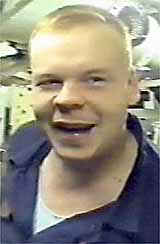Deaths which
occurred on an 12 August: ^top^
2001 Muhammad Nasser, 28, suicide bomber of Islamic Jihad, on
the patio of Wall Street Café in Haifa. No one else is killed.
Some 20 are injured, mostly lightly.
 2000
Dima Staroseltsev, Dmitri Koleshnikov, Viktor Kuznetsov, and
115 other sailors, the inexperienced crew of the
Russian nuclear submarine Kursk, on training maneuvers
in the Berents Sea. 2000
Dima Staroseltsev, Dmitri Koleshnikov, Viktor Kuznetsov, and
115 other sailors, the inexperienced crew of the
Russian nuclear submarine Kursk, on training maneuvers
in the Berents Sea.
Suddenly, at 11:28, an explosion,
probably from a mishandled torpedo, then, 2 minutes later, a
much larger explosion set off by the first, this time it is
probably many or all of the 30 torpedoes on board. The devastating
blast rips through the submerged sub, instantly killing many
of its crew. The whole prow section of the sub, its escape module,
and the escape hatch are damaged. The sub fills up with water,
drowning many who survived the explosion, and sinks to the bottom,
108 m deep.
The Russian navy's Soviet-style
public relations announces the accident one day late in a fog
of lies, starting with the insistence that it happened not on
the 12th but on the 13th. They say that some of the submariners
are heard tapping in Morse code on the hull. Later Russian misinformation
contradicts this, but there were some survivors, soon to die
from suffocation and hypothermia as they vainly hoped for rescue.
This was proved on 26 October by a note found by divers on the
body of Capt.-Lt. Koleshnikov [photo >]:
"13:15.
It is dark but I will try to write by touch. It seems there
is no chance, 10 to 20 percent. Let's hope someone reads this.
All the crew of compartments 6, 7, and 8, moved to the 9. There
are 23 persons here. We took this decision due to the accident.
None of us can go up to the surface. I write blindly. 13:5..."
(compartment 9 is the last one in the rear of the sub).
Vitya Kuznetzov, a noncom, was
from the town of Kursk, where, at 09:15 one day weeks later,
his mother, Olga, collapsed and died awaiting news that her
son's body had been retrieved. The news arrived two hours after
her death.
The United States, Britain, and
Norway, immediately offer assistance. The Russians refuse, proudly
proclaiming that the Russian rescue personel and equipment is
equal to the best in the world. After vain Russian rescue efforts
and after the alleged tapping from the trapped sailors is reported
te be no longer heard, the Russians change their stand and do
ask for Norwegian assistance on 17 August. But it is too late.
The Norwegians can only get to the scene on 20 August. In 24
hours they succeeded in what a week of Russian efforts failed
to do, opening the sub's escape hatch. They find the sub full
of water, which establishes the certainty that there are no
survivors.
Meanwhile president Putin has been seen
on TV enjoying his vacation at a Black Sea resort, making no
mention of the disaster until several days have passed and public
opinion is outraged.
On 08 October 2001, he main
body of the Kursk, would be raised from 108 m down on
be Barents Sea floor in a salvage operation is conducted from
a giant barge with computer-controlled cables by the Dutch companies
Mammoet and Smit International, contracted for some $65 million
by the Russian government. |
1985: 520 in worst single-plane
crash of history.
At 18:50 local time, a Japan
Air Lines Boeing 747SR crashes into Mount Otsuka, 110 km northwest
of Tokyo. There were 524 persons aboard, and all but four were
dead by the time rescuers reached the remote crash site 12 hours
later.
JAL flight 123 took off from
Tokyo's Haneda Airport on a domestic flight, under the command
of Captain Takahama, at 18:12 local time. Twelve minutes into
the flight, as the jumbo jet was approaching its cruising altitude,
a explosion shook the aircraft. A bulkhead had blown in the
tail, creating over-pressurization that severed the four sets
of hydraulic-control lines and blew part of the tail section
off. With a total loss of hydraulic pressure, the captain radioed
he was getting no response from his controls. For the next 27
minutes, Takahama attempted unsuccessfully to regain control
of the aircraft as it descended uncontrollably in a flight condition
known as the "Dutch roll." JAL flight 123 crashed into Mount
Otsuka at a point 4,780 feet above sea level. |
1989 William Shockley
^top^
English-born William Shockley
worked with John Bardeen and Walter Brattain at Bell Telephone
Laboratories. Together they invented the transistor, which heralded
a revolution in radio, television, and computer circuitry. The
three won the Nobel Prize in 1956 for their work with semiconductors
and their development of the transistor. In later life, Shockley
provoked outrage for his racist views and his proposal that
people of low IQ be sterilized. |
1985: 520 victims of deadliest
air crash in history ^top^
At 18:50 local time, a Japan
Air Lines Boeing 747SR crashes into Mount Otsuka, 110 km northwest
of Tokyo. There were 524 people aboard, and all but four have
died by the time rescuers reach the remote crash-site twelve
hours later. It is the worst one-plane catastrophe in history.
At 18:12, JAL flight 123 had
taken off from Tokyo's Haneda airport under the command of Captain
Takahama. Twelve minutes into the flight, as it is approaching
its cruising altitude, a depressurization explosion shakes the
jumbo jet. A bulkhead had blown in the tail, creating an overpressure
that severed the four sets of hydraulic-control lines and blew
part of the tail section off. At the same time, as a result
of a total loss of hydraulic pressure, the captain radioen that
he is getting no response from his controls. For the next twenty-seven
minutes, Takahama attempts unsuccessfully to regain control
of the aircraft as it descends uncontrollably in a "Dutch roll."
At 18:50, JAL flight 123 crashes into Mount Otsuka at an altitude
of 1457 m. |
1945 Scheffers,
mathematician
1944 Joseph Patrick Kennedy Jr. , and his co-pilot, when their
explosives-laden Navy plane blew up over England. Joseph P. was the eldest
son of Joseph and Rose Fitzgerald Kennedy, born on July 25, 1915, almost
2 years before his brother John F. who would be US president.
1935 Schottky,
mathematician.
1927 Alfred Zoff, Austrian artist born on 11 December 1852.
1913 Aimé-Nicolas Morot, French artist born on 16 June 1850.
1901 Jonquières,
mathematician.
1900 Wilhelm Steinitz Prague, Chess champion (1866-1894)
1863 Some 150 men and boys, massacred by Confederate raiders led
by William Quantrill, in Lawrence, Kansas.
1854 Antoine Chazal, French artist born on 07 Nov 1793.
1820 Manuel Lisa, fur trader. ^top^
Manuel Lisa, the first fur trader
to develop the upper Missouri River territory explored by Lewis
and Clark, dies in St. Louis. The son of either Cuban or Spanish
parents, Lisa was born in New Orleans in 1772. By the time he
was a young man he had developed extensive trading interests
along the Mississippi River, and in 1799 he chose St. Louis
as the center of his growing business. When the explorers Meriwether
Lewis and William Clark came to St. Louis in 1804, Lisa sold
them many of the supplies required for their long journey to
the Pacific. When Lewis and Clark returned to St. Louis two
years later, Lisa listened with interest to their reports of
rich beaver and otter populations to be found in the upper Missouri
River country. Lisa quickly began to organize a fur trading
expedition, and in 1807, he headed up the river in a keelboat.
Overcoming opposition from several Indian tribes along the way,
Lisa managed to reach the confluence of the Big Horn and Yellowstone
rivers in present-day Montana. There he established the Fort
Raymond (later Fort Lisa) post and began providing Indians with
manufactured goods in exchange for furs. The potential for the
upper-Missouri River fur trade was huge, and initially Lisa's
business thrived. In 1809, several prominent St. Louis men (including
Lewis and Clark) joined with Lisa to form the Missouri Fur Company.
The company ran into trouble, however, with the Blackfeet Indians
of Montana, who resented Lisa's challenge to their long-standing
dominance of the area fur trade. The War of 1812 further undermined
the business, and in 1814, the Missouri Fur Company dissolved.
Lisa continued to trade for furs on the Missouri, enjoying several
successful years and establishing excellent relations with the
Omaha tribe by marrying one of its women. Lisa made his final
trip up the Missouri in 1819, but when he returned he was suffering
from an unidentified ailment that eventually proved fatal. He
died in St. Louis in 1820 at the age of 47. Though his life
was cut short, he had already explored vast new areas of territory
and established the basic methods that would be used by the
fur trade for decades to come. |
1750 Rachel Ruysch (or Ruisch), Dutch Baroque
era painter born in 1664, specialized in Still
Life and Flowers.
— MORE
ON RUYSCH AT ART “4” AUGUST —
LINKS
— Still
Life with Flowers on a Marble Tabletop (with insects) — Flowers
on a Tree Trunk — Still-Life
with Bouquet of Flowers and Plums — A
Vase of Flowers
1676 King Philip of the Wampanoag,
assassinated for the English colonists ^top^
In colonial New England, King
Philip's War effectively comes to an end when Philip, chief
of the Wampanoag Indians, is assassinated by a Native American
in the service of the English. In the early 1670s, fifty years
of peace between the Plymouth colony and the local Wampanoag
began to deteriorate when the rapidly expanding settlement forced
land sales on the tribe.
Reacting to increasing Native
American hostility, the English met with King Philip, and demanded
that his forces surrender their arms. The Wampanoag did so,
but in 1675, a Christian Native American, who had been acting
as an informer to the English, was murdered, and three Wampanoag
were tried and executed for the crime. On June 24, King Philip
ordered a raid on the border settlement of Swansee, Massachusetts,
in response. His warriors massacred the English colonists there,
and the attack set off a series of Wampanoag raids in which
several settlements were destroyed and scores of colonists massacred.
The colonists retaliated by destroying
a number of Indian villages. The destruction of a Narragansett
village by the English brought the Narragansett into the conflict
on the side of King Philip, and within a few months several
other tribes and all of the New England colonies were involved.
In early 1676, the Narragansett were defeated and their chief
killed, while the Wampanoag and their other allies were gradually
subdued.
King Philip's wife and son were
captured, and on 12 August 1676, after his secret headquarters
in Mount Hope, Rhode Island, were discovered, Philip is assassinated.
The English drew and quartered Philip's body and publicly displayed
his head on a stake in Plymouth. King Philip's War, which was
extremely costly to the colonists of southern New England, ended
the Native-American presence in the region and inaugurated a
period of unimpeded colonial expansion. |
1674 Philippe de Champaigne, Flemish French Baroque
era painter, specialized in Portraits,
born in 1602 — MORE
ON DE CHAMPAIGNE AT ART “4” AUGUST
— LINKS
— The
Presentation at the Temple — an
earlier The
Presentation at the Temple — small Annunciation
— big The
Annunciation — The
Supper at Emmaus — The
Marriage of the Virgin — The
Penitent Magdalen — Ex
Voto — King
Louis XIII — Louis
XIII, Roi de France ( lithograph) — Cardinal
Richelieu — Cardinal
Richelieu — Triple
Portrait of Richelieu —
Bishop Jean-Pierre Camus — Jean
Baptiste Colbert — The
Nativity — Moses
with the Ten Commandments — The
Last Supper — The
Miracles of the Penitent St Mary — Cherubs
1667 Cornelis van Poelenburgh, Utrecht painter, mainly
of landscapes, born in 1586. — MORE
ON VAN POELENBURGH AT ART “4” AUGUST
— LINKS
— Children
of Frederick V Prince Elector of Pfalz and King of Bohemia
— Departure
of an Oriental Entourage — Young Girl
— The Flight to Egypt
— Rest
on the Flight to Egypt — Rest
on the Flight into Egypt — Ruins
of Ancient Rome — Odysseus and Minerva
— Adoration by the Magi
— Cimone
and Efigeneia — Meeting of the gods
in the clouds — Mercurius and Herse
— The
rest on the Flight to Egypt — The Waterfalls of Tivoli.
1580 Luca Longhi “le Raphäel de Ravenne”, Italian
artist born on 14 January 1507.
1546 Francisco de Vitoria, Spanish Dominican theologian, born
in 1486. He is best remembered for his defense of the rights of the Amerindians
against the Spanish colonists and for his ideas of the limitations of
justifiable warfare.
|
 On
an 12 August:
On
an 12 August:  [< U 5~year
price chart].
[< U 5~year
price chart].
 2000
Dima Staroseltsev, Dmitri Koleshnikov, Viktor Kuznetsov, and
115 other sailors, the inexperienced crew of the
Russian nuclear submarine Kursk, on training maneuvers
in the Berents Sea.
2000
Dima Staroseltsev, Dmitri Koleshnikov, Viktor Kuznetsov, and
115 other sailors, the inexperienced crew of the
Russian nuclear submarine Kursk, on training maneuvers
in the Berents Sea.